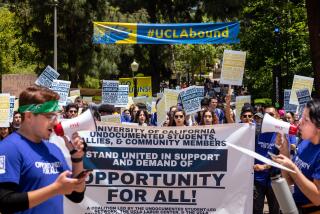Affirmative action -- not required
The University of California’s plea to the U.S. Supreme Court, filed earlier this month, to uphold race-based affirmative action in college admissions is -- in effect -- a confession of failure.
UC’s plea comes in an amicus brief in a crucial case challenging affirmative action at the University of Texas. If the court declares the Texas policy unconstitutional, as it well may, it would mark the end of affirmative action in all public higher education in America and, just possibly, for any private institution getting federal funds.
In California, the end came long ago, with a UC Board of Regents’ vote in July 1995 and the passage in November 1996 of Proposition 209, which barred all race preferences in public education, contracting and employment. Oddly enough, UC’s brief doesn’t mention the regents’ vote -- the embarrassing fact that the original ban was self-inflicted.
UC offers itself as a test case. In the years since 1996, it says in its amicus brief, it’s tried every strategy other than using race to restore the percentages of “underrepresented minorities” -- African Americans and Latinos principally -- to the level of enrollment before the ban went into effect.
In 1995, the brief says, African American students represented 7.3% of admitted freshmen at Berkeley; in 2012 it was projected to be 3.5%; at UCLA, the number is down from 6.7% to 3.8%. In the same years, even as the number of Latino high school graduates in California increased by 36%, Latino enrollment at Berkeley declined. Minority enrollment at UC’s professional schools is similarly low.
None of the alternative efforts, from intense outreach programs to major changes in admissions policy, the brief says, have been completely successful. That failure seriously undermines UC’s “ability to discharge its role as ‘the training ground for a large number of our nation’s leaders.’ ” It goes on to say, “Race-neutral admissions policies cannot fully guarantee diverse student bodies.”
UC acknowledges that systemwide the absolute number of Latinos has increased substantially, even though it declined at the most popular campuses -- in the fall of 1995, UC Riverside had 344 Latino freshmen, 22% of the class; in 2011, the freshman class included 1,438 Latinos, 40% -- but not rapidly enough to keep up with the number of Latino high school graduates, which has been rising even faster during the past decade and a half.
What it doesn’t say is that in the California State University system, for which the top third of all state high school graduates is theoretically eligible (at UC it’s the top 12.5%) there are now almost as many Latinos as non-Latino whites: In 2010, there were 100,000 Latinos, and 115,000 whites.
In the same year, according to the College Board, California’s community colleges enrolled 513,000 Latinos (up from 255,000 in 1996) and 506,000 whites (down from 519,000 in 1997). Nor does the brief point out that since the end of affirmative action, the graduation rate for so-called underrepresented minorities at UC has increased substantially. According to UC data, 17% of African Americans who entered UC in 1992 graduated in four years; of those who began in 2007, 45% graduated in four years; 71% graduated in six years. Of those who entered in 1994, 57% had graduated in six years.
There are similar numbers for Latinos, and even for whites, but hardly as dramatic. Six-year graduation rates among whites increased from 76% to 85%, according to UC data; for Latinos, from 66% to 75%.
The UC brief correctly voices deep concern about the importance of enrolling students from a wide spectrum of backgrounds in a society as socially and ethnically diverse as California -- or as Texas -- or as much of America is coming to be. The inability of an institution like the University of California to consider ethnicity also puts it at a disadvantage with private institutions, which can.
But throughout our nation’s history, city colleges and community colleges have generally been the first rung on the educational ladder for students whose parents didn’t go to college. When selective research universities such as UC Berkeley, UCLA and UC San Diego, which aspire to rank among the most highly regarded institutions in America, if not in the world, try to also be representative of the state’s population -- to be elite and democratic too -- they may well aspire to be something that never was and never will be.
It becomes more difficult in tough economic times. Eight years ago, Richard Atkinson, who had recently retired as UC’s president, pointed out that California enrolled a smaller proportion of its college-age population in higher education than virtually every other state. He proposed enlarging the pool of UC-eligible students to maybe the top 15% and at CSU by a proportionate amount.
At a time when budget cuts have forced retrenchment in all education, and sharp tuition increases, such proposals may seem hopelessly quaint. But they point to a problem that’s deadly serious. If we were serious about greater diversity and better opportunities for minorities, we would open the doors much wider, not continue to close them. That -- and improved high school preparation -- would do more than any return to the divisive race-conscious tinkering of the past.
More to Read
Sign up for Essential California
The most important California stories and recommendations in your inbox every morning.
You may occasionally receive promotional content from the Los Angeles Times.










